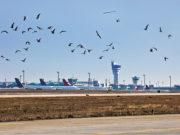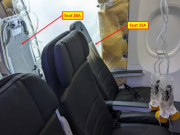The U.S. National Transportation Safety Board (NTSB), citing three accidents in which bird strikes involving relatively small birds resulted in engine failures, is recommending action to prevent the catastrophic failure of Pratt & Whitney Canada (PWC) JT15D-5 engines on Beechcraft Beechjet 400A airplanes after bird strikes or foreign object ingestion.
The NTSB said it had investigated three events in which “liberated fan blades breached engine cases and cowlings after bird species well below the weight required for certification testing were ingested.”
The most recent accident occurred May 13, 2014, when a Beechjet 400A struck a bird during takeoff from Sugar Land Regional Airport in Texas and the right engine burst into flames. The flight crew rejected the takeoff and discharged two fire bottles, extinguishing the fire. Examination of the engine showed that the fan blades had been fractured near the root, the engine cowling had multiple penetrations and blade fragments had struck the inlet cowl.
Similar events occurred on other Beechjet 400As in July 2009 and March 2014, the NTSB said.
In all three cases, the birds were of species that typically weigh less than 4 lb (2 kg). When the JT15D-5 engine was certificated, requirements called for it to be capable of surviving the ingestion of a 4-lb bird.
As a result of the accidents, the NTSB recommended that Transport Canada require all JT15D-5 engines in Raytheon/Hawker Beechjet 400As “be modified to dampen the rub-induced excitation that can occur between the engine fan and fan case during bird strike or foreign object ingestion events.”


